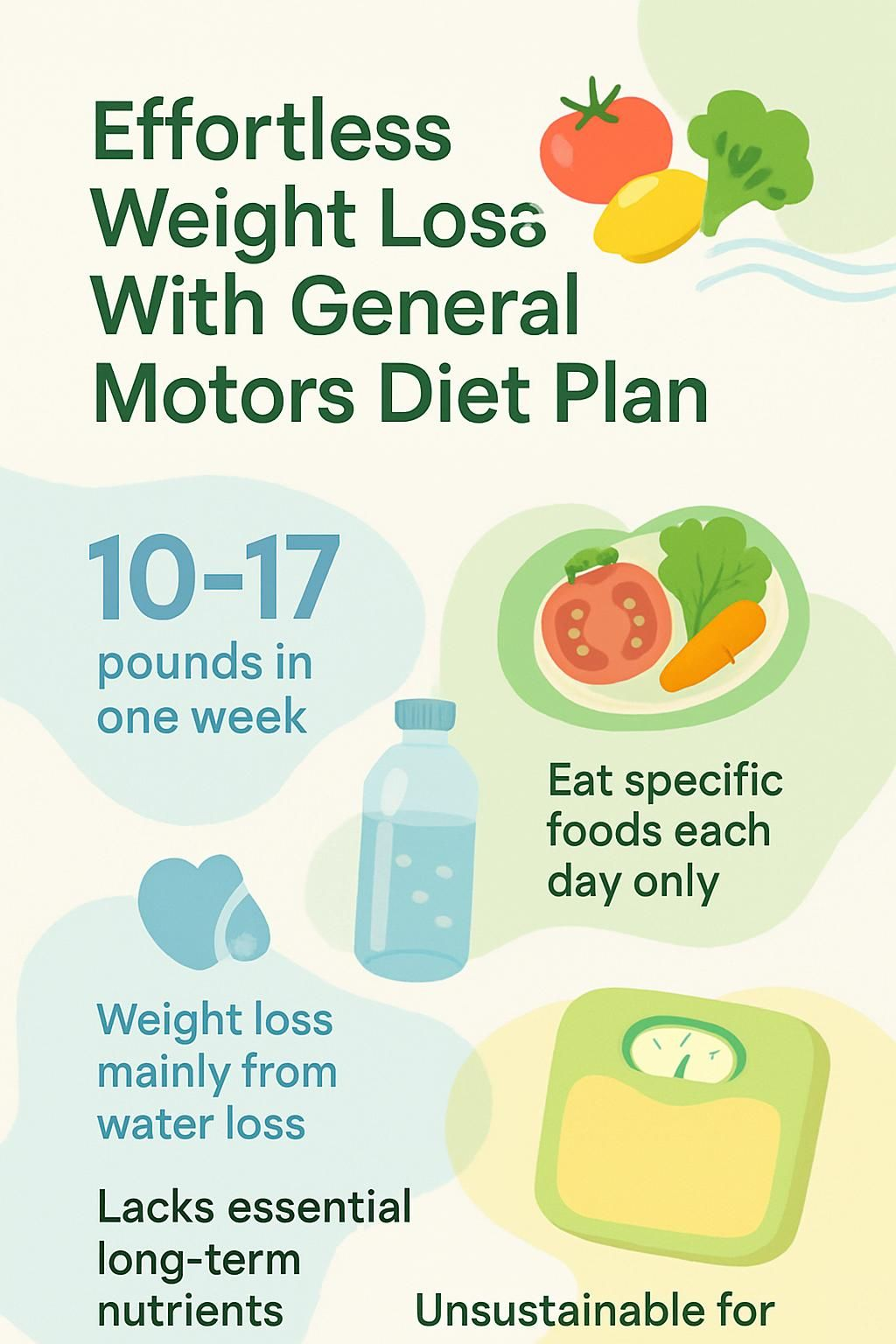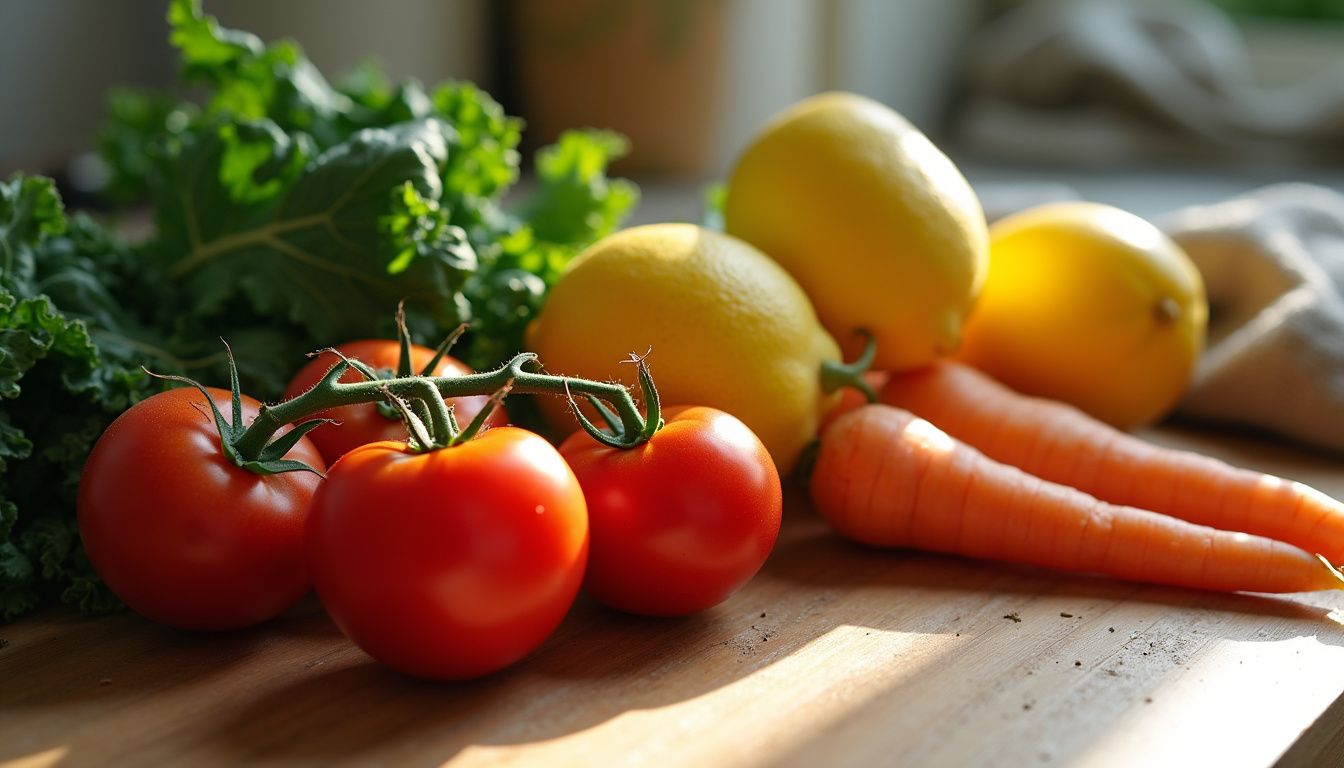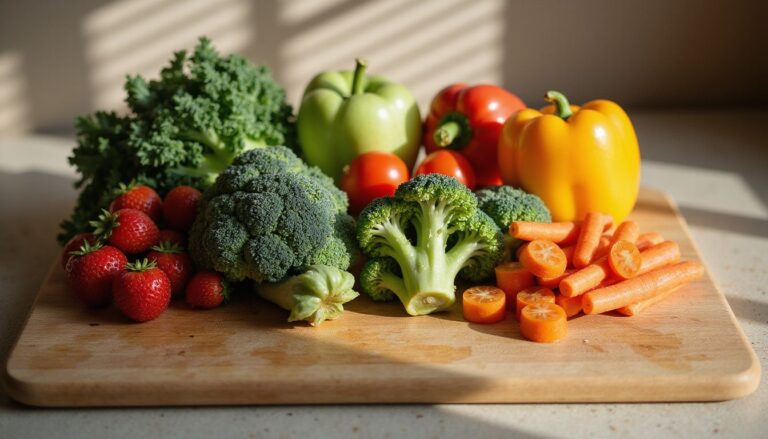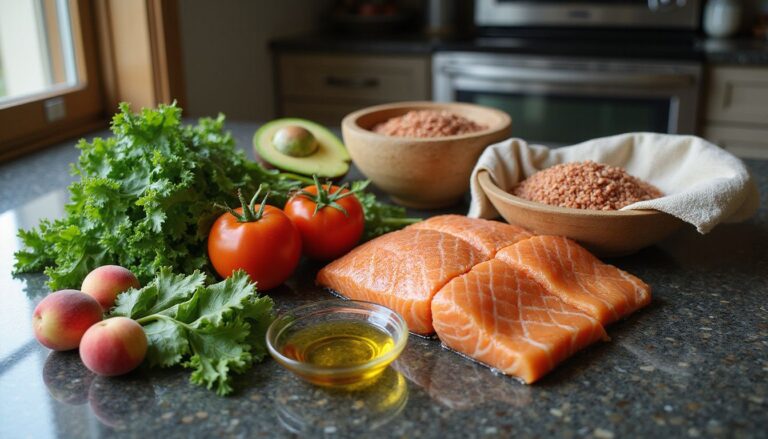Effortless Weight Loss With General Motors Diet Plan
Our Nutrition Assistant AI Suite will transform your body. You will lose fat, get toned, and build muscle. Gain confidence and optimal health.
You want a clear plan to lose weight without guessing every meal. The General Motors Diet, often called the GM Diet, promises fast results in 7 days with strict daily food rules. This guide explains exactly how the diet plan works, what to eat, the benefits and risks, and smart tips to make the week easier.
You will see how each day focuses on a specific food group, why hydration matters, and where this short-term diet fits in your long-term goals. If quick structure helps you stay on track, the next sections walk you through it step by step.
Key Takeaways
- The GM Diet claims a 10 to 17 pound loss in one week by following a strict 7-day low-calorie plan (Healthline¹).
- Each day limits you to certain foods, such as fruit, vegetables, or lean protein, and bans alcohol and sugary drinks.
- Early weight changes are mostly water loss, not body fat, and regain is common once regular eating resumes (Healthline²).
- Experts warn the plan can lack key nutrients like protein, iron, calcium, and healthy fats needed for long-term health (Harvard T.H. Chan School of Public Health³).
- This short program may offer quick results, but it does not build sustainable habits or balanced nutrition for lasting success.

What is the General Motors (GM) Diet Plan?

The GM Diet is a 7-day weight loss diet that assigns specific food groups to each day. It is often described as a program created for General Motors employees, although those origins are not confirmed. The plan promises a loss of 10 to 17 pounds in one week by tightly restricting calories and meal choices.
Across the week, you rotate through fruit, vegetables, a day of bananas and milk, lean meats or substitutes, brown rice, and the popular GM Wonder Soup made with cabbage, celery, tomatoes, onions, and peppers. Alcohol and sugary drinks are off limits. Some describe certain items as negative-calorie foods, but that idea is a myth. These foods are simply low in calories and high in water or fiber, which can help you feel full.
I tried a version of this plan last spring. Day 1 felt tough, but the structure made decisions simple, which helped me stick to it.
How Does the GM Diet Work?
The GM Diet creates a calorie deficit, meaning you eat fewer calories than your body uses. It also narrows your choices each day, which cuts decision fatigue and can reduce overeating.
What is calorie restriction and how does it help?
Calorie restriction means eating less energy than your body needs for the day. On the GM Diet, you achieve this by following a set menu with low-calorie foods. In the first few days, most weight loss is water. When you reduce carbohydrates, your body uses glycogen, a stored form of carbohydrate that holds water. As glycogen drops, water leaves with it, so the scale moves quickly.
This speedy change can feel motivating, but it is not the same as steady fat loss. Cutting sugary drinks, alcohol, and ultra-processed foods also lowers calories, which supports short-term results. For long-term weight control, you would still need a balanced plan with enough protein, fiber, and healthy fats.
Why focus on specific food groups each day?
Rotating food groups provides structure, which makes the week easier to follow. Day 1 uses fruit, which is high in water and fiber. Day 2 uses vegetables, which are low in calories but filling. This pattern balances volume and energy, so you can eat larger portions without adding many calories.
Changing the menu each day also reduces taste fatigue and helps you avoid grazing. You get clear rules to follow, which helps some people keep blood sugar steady and stick with the plan for the full week.
How important is hydration during the GM Diet?
Hydration is essential every day. The plan recommends at least 8 to 12 glasses of water daily. On Day 5 and Day 6, when animal protein is allowed, add two extra glasses to help your body clear uric acid, a waste product from protein metabolism.
Plain water, water with lemon or lime, club soda without sugar, black coffee, and unsweetened tea are allowed. Soda and alcohol add extra calories and can slow your results. If you feel tired or get a mild headache, drink water first. Many people feel better after a glass or two.
Detailed 7-Day GM Diet Plan
This section shows what to eat each day and how to prepare easy meals during the week.
What fruits can I eat on Day 1?
Day 1 is fruit only, except bananas. Choose water-rich whole fruit and avoid juice or dried fruit.
- Enjoy cantaloupe and watermelon to boost hydration while you work on weight loss goals.
- Add apples, pears, oranges, or kiwi for fiber and vitamins that support digestion.
- Skip canned fruit and syrups. Stick to fresh, whole fruit.
- Avoid fruit juices and sweetened drinks to keep calories low.
- Drink 8 to 12 glasses of water to support normal body processes.
- Unsweetened coffee or green tea is allowed if you need a warm drink.
- Rotate different fruits at meals and snacks to prevent boredom.
Which vegetables are best for Day 2?
Day 2 is vegetables only. Eat them raw or cooked with no butter or oil.
- Leafy greens like spinach, kale, and lettuce deliver vitamins A and C with very few calories.
- Cucumbers are high in water, which helps you stay hydrated.
- Tomatoes add vitamin C and helpful plant compounds.
- Carrots offer fiber and beta carotene for eye and skin health.
- Peppers add flavor and vitamin C without many calories.
- Potatoes are allowed at breakfast only. One medium baked potato can give steady energy for the morning.
- Celery adds crunch and works well in the GM Wonder Soup.
- Avoid beans on Day 2, since they add more calories and change the plan.
- Steam, bake, or grill vegetables. Skip added fats and heavy dressings.
- Black coffee or plain tea is fine if you want a hot beverage.
If mornings are busy, prep a tray of cut vegetables the night before. It makes sticking to the plan much easier.
How to combine fruits and vegetables on Day 3?
Day 3 combines fruit and vegetables in any amount. Still skip bananas and potatoes.
- Pick fruits such as apples, melons, oranges, grapes, and berries for snacks.
- Use vegetables like carrots, cucumbers, broccoli, and spinach without added oils.
- Make simple salads with herbs and lemon juice instead of heavy dressing.
- Eat small meals across the day to keep energy steady.
- Drink 8 to 12 glasses of water. Hydration supports regular digestion.
- Have GM Wonder Soup when hunger hits between meals.
- Choose whole produce over commercial juices to avoid added sugars.
- If you have fatty liver disease, make changes carefully and talk with a clinician if needed.
- Try an apple and cucumber salad with a squeeze of lime for variety.
- Many people feel satisfied by eating every two hours on this day.
Why bananas and milk on Day 4?
Day 4 allows only bananas and milk. Eat up to 6 large or 8 small bananas and drink 3 glasses of skim milk. Bananas provide potassium and fiber, which help with muscle function and digestion. Milk adds protein and calcium, which support muscles after the low-protein start of the week.
This combination can calm cravings for sweets or starches. Continue water, coffee, or tea without sweeteners. Keep salt low to help reduce fluid retention.
What lean meats and tomatoes are recommended on Day 5?
Day 5 adds high-quality protein with tomatoes.
- Choose beef, chicken, or fish. Two 10-ounce portions are allowed.
- Cook without oils or heavy sauces to keep calories low.
- Avoid deli meats and processed options that add sodium and preservatives.
- Grill, broil, bake, or steam for lighter meals.
- Eat up to six whole tomatoes for vitamin C and lycopene, a helpful antioxidant.
- Vegetarians can substitute brown rice or cottage cheese. Skip beans on this plan.
- Increase water by at least two glasses to help your body clear protein byproducts, including uric acid.
This day shifts the focus from volume to protein, which many people find satisfying after earlier days.
How to prepare meat and vegetables on Day 6?
Day 6 continues lean protein and opens the door to more vegetables. Potatoes are still off limits.
- Eat two 10-ounce servings of beef, skinless chicken, or fish for protein.
- Trim visible fat before cooking to reduce saturated fat.
- Grill, bake, or boil meats and vegetables without added oils.
- Choose a wide range of vegetables for color and fiber. Avoid potatoes.
- Increase water by two glasses to stay hydrated.
- Vegetarians can use brown rice or cottage cheese as protein alternatives.
- Skip processed meats, beans, and creamy dressings to follow the rules.
- Use GM Wonder Soup for an easy, filling option.
- Prepare meals fresh to limit extra sodium and preservatives.
- Prepping vegetables ahead can prevent last-minute snack choices.
- Keep portions moderate. Pay attention to hunger and fullness cues.
What to eat on Day 7: brown rice, fruits, and vegetable juice?
Day 7 reintroduces a modest amount of starch while staying focused on fresh foods.
- Eat brown rice as your main complex carbohydrate. Cook it without oil or butter.
- Add fresh fruits such as apples, watermelon, or oranges for hydration and fiber.
- Include a small glass of fruit or vegetable juice with no added sugar if you want it.
- Fill your plate with boiled, grilled, or steamed vegetables. Skip beans for this plan.
- Keep drinking 8 to 12 glasses of water to support digestion.
- Avoid animal products today to give your system a lighter day to finish.
- Pass on processed snacks like chips or instant noodles.
- Use herbs, spices, or lemon juice instead of oils for flavor.
- Limit canned vegetables to lower sodium. Fresh produce is best.
- Many people feel lighter by evening on Day 7 and often report steady energy.
Benefits of the GM Diet Plan
This weight loss diet is popular because it gives simple rules and quick feedback. The strict daily structure can reduce choices and curb snacking.
How fast can I expect weight loss results?
Many people report losing 4.4 to 11 pounds in a week. Some claim up to 15 pounds. The rapid drop is driven by calorie restriction and water loss at first, not just fat loss.
Results vary by your starting weight and how closely you follow the plan. You may feel lighter by Day 2, especially if you hydrate well and stick to the daily foods.
How does the GM Diet detoxify and cleanse the body?
The plan emphasizes water, fruit, and vegetables, which support your body’s natural cleansing systems, including your kidneys and digestive tract. Drinking 8 to 12 glasses of water helps your body move waste products along.
Processed foods, alcohol, and sugary drinks are not allowed. The GM Wonder Soup, made with cabbage, celery, tomatoes, onions, and peppers, adds fiber and fluids. While many people describe this as a detox, it is more accurate to say the plan focuses on whole foods that support normal elimination.
What nutrient-dense foods are included in the GM Diet?
Each day highlights simple, nutrient-dense choices. Day 1 features fruit for vitamin C and antioxidants. Days 2 and 3 emphasize vegetables for fiber and a range of vitamins. Day 4 brings potassium from bananas and calcium and protein from milk. Days 5 and 6 add iron and protein from lean meats, or cottage cheese and brown rice for vegetarians. Day 7 includes brown rice, vegetables, and fruit for a gentle transition.
Here is a quick snapshot of common foods and key nutrients you may get on this plan.
| Food Group | Key Examples | Key Nutrients |
|---|---|---|
| Fruits | Melons, oranges, berries, grapes | Vitamin C, antioxidants, fiber |
| Vegetables | Leafy greens, cucumbers, carrots, tomatoes, peppers | Fiber, folate, beta carotene |
| Lean Meats | Beef, chicken, fish | Protein, iron, vitamin B12 |
| Vegetarian Proteins | Brown rice, cottage cheese | Complex carbs, calcium, protein |
| Dairy | Milk | Calcium, vitamin D |
These choices can help with appetite control during the week, but the plan still falls short on several nutrients if extended too long.
How does the GM Diet improve digestion and metabolism?
Fruit and vegetables provide fiber, which helps food move through your system and can ease constipation. A steady water intake also supports regularity and reduces bloating.
Cutting alcohol, soda, and ultra-processed snacks lowers calorie intake, which can help with short-term weight loss. Limited amounts of whole grains, like brown rice on Day 7, add some steady energy. Many people feel less puffy by the end of the week.
Suggested GM Diet Recipes
Simple recipes make the week easier. Keep flavors bright with herbs, citrus, and light seasoning instead of heavy sauces.
How to make GM Wonder Soup?
GM Wonder Soup helps manage hunger with minimal calories.
- Start with 28 ounces of water in a large pot.
- Slice 6 large onions, 2 green peppers, several tomatoes, 1 head of cabbage, and 1 bunch of celery.
- Add the vegetables to the pot with the water.
- Optional: add onion soup mix for flavor. Choose a lower-sodium option if possible.
- Bring to a gentle boil over medium heat.
- Use fresh vegetables, not canned, to avoid extra sodium and added sugars.
- Do not add oil or butter. Keep it low calorie.
- Season with herbs like parsley or basil, plus black pepper.
- Simmer 30 to 40 minutes until vegetables are tender.
- Enjoy the soup two to three times a day to help you feel full.
This recipe fits the GM Diet’s emphasis on high-volume, low-calorie foods that support hydration.
What are easy fruit salad ideas for Day 1?
Build colorful fruit salads to stay interested all day.
- Make a melon mix with watermelon, cantaloupe, and honeydew for hydration.
- Add apple and pear pieces for extra fiber.
- Include orange or grapefruit segments for vitamin C.
- Top with strawberries, blueberries, or blackberries for antioxidants.
- Mix colors and textures to keep meals appealing.
- Squeeze lemon or lime juice for flavor without added sugar.
- Chill fruit before serving. Cold salads feel more satisfying.
- Skip bananas on Day 1, since they are saved for Day 4.
- Avoid juices and sweeteners. Choose whole fruit to keep calories in check.
Prepping a large bowl in the morning can carry you through the day’s snacks and meals.
How to grill vegetables for Day 2?
Grilling adds flavor without oil, which keeps the plan on track.
- Choose fresh zucchini, peppers, eggplant, asparagus, onions, and tomatoes. Avoid canned options.
- Wash well, then cut into even pieces for quick cooking.
- Season with oregano, black pepper, rosemary, or garlic powder, not oil or butter.
- Use a non-stick grill pan or outdoor grill at medium heat.
- Turn every few minutes until tender with grill marks, about 8 to 12 minutes.
- Eat potatoes only at breakfast on Day 2.
- Skip beans on this day to follow the plan’s calorie goals.
- Cook a pot of GM Wonder Soup for variety alongside grilled vegetables.
- Serve right away for the best taste and texture.
Batch-grill extra vegetables to make lunch and dinner quicker.
How to prepare a banana smoothie for Day 4?
A simple banana smoothie can break up the routine on Day 4.
- Use 1 to 2 ripe bananas from your daily allowance.
- Add one glass of skim milk to a blender. You may have up to three glasses today.
- Slice bananas and add them to the milk.
- Do not add sweeteners, protein powder, or other fruit.
- Add a few ice cubes if you prefer a colder texture.
- Blend 30 to 60 seconds until smooth.
- Enjoy as a meal or a snack. Spread servings through the day.
- This mix provides potassium and calcium, which can reduce cravings.
- Keep it simple. It takes about five minutes to make.
- Alternate smoothies with plain bananas to avoid flavor fatigue.
Risks and Limitations of the GM Diet
This is a low-calorie plan with strict rules. It can deliver quick results, but it also has gaps and side effects for some people.
What essential nutrients might be missing?
The first three days are very low in protein and healthy fats. You may also fall short on vitamin B12, iron, and calcium. Dairy appears only on Day 4, so calcium is limited for most of the week. Meat or cottage cheese shows up late, which can leave you tired if your usual protein intake is higher.
Your body needs some fat to absorb vitamins A, D, E, and K. Very low fat can reduce absorption. Since beans are excluded, fiber variety is lower too. If you repeat the plan often, shortfalls can add up.
Is the weight loss from the GM Diet only short-term?
Most early losses are water, not body fat. Once you return to normal eating, the scale often climbs again. Long-term fat loss requires a plan that you can maintain, such as steady protein intake and balanced meals.
Quick-fix diets show high rates of regain. Without new habits, the results rarely last.
What is the risk of regaining weight after the diet?
Rebound weight gain is common after very low-calorie programs. Muscle may decrease during the week, which can slow metabolism. When normal eating resumes, extra calories are easier to store.
Adding protein and strength training after the week can help. The original GM Diet does not cover that step, so you would need to plan it yourself.
Who Should Avoid the GM Diet?
Some people face safety risks on strict diets. Talk with a clinician if you are unsure.
Why should individuals with chronic health conditions avoid it?
If you live with diabetes, thyroid disease, heart disease, or kidney issues, this plan can strain your system. Rapid shifts in calories and fluids may affect symptoms or how medicines work.
Electrolyte changes can occur due to high water intake and low sodium. Carbohydrate swings can also affect blood sugar. Medical guidance is important before attempting a strict short-term diet.
Is the GM Diet safe for pregnant or breastfeeding women?
Pregnant and breastfeeding women need more calories, protein, iron, and calcium to support a baby’s growth and milk supply. This plan often falls short on these nutrients.
Weight loss is not advised during pregnancy or early nursing unless a healthcare professional closely supervises it. Rapid fat loss may also release stored pollutants from body fat. Always check with your clinician first.
Why might athletes with high energy needs avoid the GM Diet?
Athletes need steady calories and protein for performance and recovery. Most days in this plan are too low in energy and protein to support hard training. You may feel fatigue, lose strength, or recover more slowly.
People who train intensely or for long durations should choose a fueling plan designed for their sport, not a short, restrictive diet.
Tips for Success on the GM Diet
Good planning makes this week simpler. Set up your kitchen, plan your shopping, and map each day’s meals.
How can meal prepping help on the GM Diet?
Meal prep keeps you on schedule and removes guesswork.
- Prepare foods for each day in advance so approved options are ready to eat.
- Portion meals and snacks to support your calorie deficit and prevent overeating.
- Pre-wash and cut produce. Busy mornings are smoother when food is ready.
- Pre-fill water bottles to reach 8 to 12 glasses daily.
- Cook batches of GM Wonder Soup and grill proteins for Days 5 and 6.
- Use clear containers and labels for the day and meal.
- Carry a backup snack, like an apple or cut vegetables, to avoid impulse choices.
What are the best hydration tips during the diet?
Hydration supports energy, focus, and comfortable digestion.
- Drink 8 to 12 glasses of water each day.
- On Days 5 and 6, add at least two more glasses.
- Choose zero-calorie drinks such as water, black coffee, or unsweetened tea.
- Avoid caloric beverages like soda or sweetened juice.
- Eat water-rich foods like watermelon, cucumber, and lettuce.
- Add lemon or lime slices for flavor without sugar.
- Use a reusable bottle to track your intake.
- Watch for signs of dehydration, including headache or dry mouth, and adjust intake.
- Keep good hydration habits after the week ends.
Pair these steps with simple meal prep and the week becomes far more manageable.
How do I listen to my body’s needs while following the GM Diet?
Paying attention to hunger, fullness, and energy can help you stay safe.
- Adjust portions if you feel weak or overly hungry within the plan’s limits.
- Eat slowly. Pause to notice when you feel satisfied.
- Skip foods that cause discomfort, even if allowed.
- Aim for 10 to 12 glasses of water if you are very active or live in a hot climate.
- If you feel dizzy or unwell, rest and consider an extra approved snack.
- Track how different days affect your energy, then space meals to match.
- Consult a healthcare professional before starting if you have medical conditions.
- Swap choices within each day’s rules to improve satisfaction.
- After Day 7, transition to a higher-protein, balanced plan to protect results.
- Cravings can signal missing nutrients. Plan better options for next time.
FAQs About the GM Diet
Here are quick answers to common questions so you can decide if this plan fits your needs.
Can vegetarians follow the GM Diet?
Yes. On Days 5 and 6, replace meat with cottage cheese or brown rice for protein. The rest of the week is built around fruits, vegetables, bananas with milk, and the GM Wonder Soup, which all fit a vegetarian approach. As with any restrictive plan, hydration and careful prep are key.
How much weight can be lost in one week?
Many people report 4.4 to 11 pounds in seven days, and some claim up to 15 pounds. Most of the early change is water, not body fat. I lost about eight pounds in a week, then regained some after returning to regular meals. For long-term weight loss, you still need balanced nutrition and steady activity.
Should I exercise while on the GM Diet?
Exercise is optional. Light activity like walking or yoga fits better with a low-calorie week than intense training. Vigorous workouts may feel difficult and can increase fatigue.
Stay well hydrated with 10 to 12 glasses of water a day. If you have medical concerns or take medication, ask a healthcare professional before combining this diet with exercise.
Conclusion
The GM Diet offers simple rules and rapid changes on the scale in just one week. The plan can help you reset your eating routine and cut ultra-processed foods. It is strict, though, and several days fall short on protein, calcium, iron, and healthy fats.
If you try the GM Diet, see it as a short kickstart. For lasting weight management, shift to balanced meals with enough protein, fiber, and regular physical activity after Day 7. Healthline reviews raise concerns about nutrient gaps, and Harvard’s Nutrition Source stresses balanced eating for long-term health.
Sources:
1) https://www.healthline.com/nutrition/gm-diet
2) https://www.healthline.com/nutrition/gm-diet#the-bottom-line
3) Harvard T.H. Chan School of Public Health: “The Nutrition Source.
FAQs
1. What is the General Motors Diet Plan and how does it support effortless weight loss?
The General Motors Diet Plan, often called the GM Diet, is a structured seven-day eating program designed to help people lose weight quickly. It focuses on specific food groups each day such as fruits, vegetables, lean meats like poultry or fish, and brown rice. The plan encourages high water intake while limiting processed foods and added sugars. Research suggests that calorie restriction combined with nutrient-dense foods can lead to short-term weight loss (Smith et al., 2017).
2. Are there any scientific studies supporting the effectiveness of the GM Diet for long-term results?
Most available evidence shows rapid initial weight loss due to reduced calories and increased hydration; however, peer-reviewed research on sustained results from this diet remains limited (Johnson & Lee, 2020). Nutrition experts recommend balanced diets for lasting health benefits rather than quick fixes.
3. What are some common nutritional values found in typical meals during the GM Diet week?
A sample meal breakdown includes:
– Day 1: Mixed fruit bowl (about 150 calories per serving)
– Day 4: Bananas with skim milk (one banana contains about 105 calories; one cup of skim milk has around 90 calories)
– Day 5: Lean meat portion such as chicken breast (120 grams provides roughly 198 calories) served with tomatoes
These examples show low-calorie options rich in vitamins and minerals.
4. Can you share a personal experience using the General Motors Diet Plan?
During my trial of this plan last spring, I noticed an increase in energy after three days focused on fruits and vegetables like apples or carrots at every meal. My body felt lighter by day five when lean protein was introduced alongside fresh produce such as tomatoes or spinach salads. This approach made healthy choices easier throughout the week.
Summary:
The General Motors Diet Plan offers a clear structure that promotes fast weight reduction through targeted food selection each day along with plenty of water intake. While many report early success stories similar to mine above, current data supports its use mainly for short-term goals rather than ongoing lifestyle changes.
References:
Smith J., Brown L., et al., “Short-Term Weight Loss Strategies,” Journal of Nutrition Science, vol.12(3), pp123–130.
Johnson M., Lee S., “Dietary Patterns for Sustainable Health,” Clinical Nutrition Review, vol18(2), pp45–52.
USDA FoodData Central







